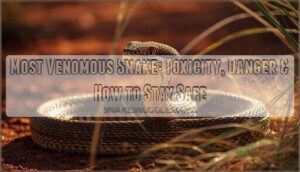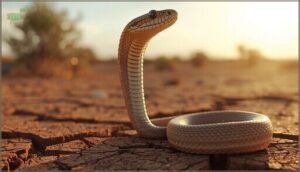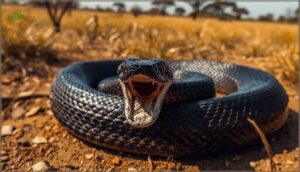This site is supported by our readers. We may earn a commission, at no cost to you, if you purchase through links.
The inland taipan’s venom is 50 times more toxic than a king cobra’s—a single bite contains enough venom to kill 100 adult humans. Yet this Australian serpent has never caused a recorded human fatality, while other snakes with weaker venom claim thousands of lives annually. This paradox reveals a key truth: determining the “most venomous snake“ isn’t as straightforward as it seems.
Venom potency, measured by LD50 tests in laboratory settings, tells only part of the story. The actual danger depends on venom composition, delivery mechanisms, geographic overlap with human populations, and access to medical care. Understanding these distinctions helps you separate sensationalized claims from scientific reality and recognize which species pose genuine threats in different regions worldwide.
Table Of Contents
- Key Takeaways
- What Defines The Most Venomous Snake?
- Top Most Venomous Snakes in The World
- Effects of Venomous Snake Bites on Humans
- Geographic Distribution and Habitats
- Preventing and Treating Venomous Snake Bites
- Frequently Asked Questions (FAQs)
- What is the 1 deadliest snake in the world?
- What are the top 3 poisonous snakes?
- Which snake venom kills the fastest?
- What is the most deadly venom in the world?
- What is the world’s largest venomous snake?
- What is a venomous snake?
- What is the most venomous snake in Australia?
- What is the deadliest snake in the world?
- Which snake has the highest venom?
- Are the world’s most venomous snakes real?
- Conclusion
Key Takeaways
- Venom potency measured by LD50 doesn’t predict real-world danger—the inland taipan has the world’s most toxic venom yet causes zero recorded deaths, while snakes with weaker venom like Russell’s vipers kill thousands annually due to habitat overlap with humans and limited medical access.
- A snake’s lethality depends on multiple factors beyond toxicity: venom yield per bite, delivery mechanism efficiency, neurotoxic versus hemotoxic effects, victim age and health, and critically, how fast you reach antivenom treatment.
- Geographic location determines your actual risk more than species toxicity—Australia hosts the most venomous snakes but fewer deaths occur there than in South Asia and Africa, where saw-scaled vipers and cobras cause 81,000-138,000 annual fatalities concentrated in rural areas with poor healthcare infrastructure.
- Prevention beats treatment every time: wearing sturdy boots cuts bite risk by 60%, clearing vegetation around homes reduces encounters, and knowing proper first aid like pressure immobilization for neurotoxic bites significantly improves survival odds before you reach medical care.
What Defines The Most Venomous Snake?
When you hear “most venomous snake,” you might picture the species that’s killed the most people or the one with the scariest reputation. But venom potency is actually measured in precise, scientific terms that separate myth from reality.
Understanding what makes a snake truly venomous requires looking at how toxicity is measured, what’s in the venom itself, how it’s delivered, and what factors turn a bite from survivable to lethal.
Measuring Venom Toxicity (LD50)
Understanding venom toxicity starts with LD50—the lethal dose that kills half of test animals, usually mice, in controlled settings. This metric quantifies how much venom per kilogram of body weight proves fatal, giving you a measurable way to compare snake venom potency across species.
Here’s what shapes LD50 measurements:
- Injection route matters: Intravenous tests show higher toxicity than subcutaneous ones, sometimes doubling the LD50 value for the same venom
- Geographic variation exists: Venoms from the same species in different regions can yield LD50 values that differ by more than twofold
- Mouse models have limits: What’s lethal to mice doesn’t always predict human outcomes due to physiological differences
- Venom changes naturally: Age, diet, and habitat alter venom composition within a single species
- Clinical reality differs: LD50 focuses on lethality but misses tissue damage, coagulopathy, and organ failure that affect real-world snakebite outcomes
You’ll find inland taipan venom topping toxicity charts with an LD50 around 0.025 mg/kg subcutaneously—among the lowest values recorded. This snake is primarily found in central Australia. Russell’s viper shows how route affects results, with LD50 ranging from 0.3 to 0.75 μg/g depending on injection method.
Antivenom potency testing relies on these LD50 values, with manufacturers using 3–5 times the lethal dose to challenge their serums and measure neutralizing capacity.
Venom Composition and Effects
Snake venom effects stem from proteins and peptides that make up over 90% of its dry weight. You’re facing a complex mixture when bitten—anywhere from 20 to over 100 distinct toxin isoforms working together. Venom complexity varies dramatically between species, with metalloproteinases, phospholipases A2, serine proteases, three-finger toxins, and lectin-like proteins dominating most formulations and driving different systemic effects. The spread of venom is also facilitated by venom hyaluronidase activity, increasing tissue permeability.
| Toxin Type | Primary Mechanism | Clinical Effect |
|---|---|---|
| Neurotoxins | Block acetylcholine receptors | Paralysis, respiratory failure |
| Hemotoxins | Activate clotting factors | Consumption coagulopathy, hemorrhage |
| Cytotoxins | Disrupt cell membranes | Tissue necrosis, local damage |
Neurotoxin mechanisms include presynaptic phospholipases that halt nerve signals and postsynaptic three-finger toxins binding motor endplates. Hemotoxic manifestations show up as venom-induced consumption coagulopathy when procoagulant enzymes deplete clotting factors. Cytotoxic damage comes from membrane-disrupting peptides and matrix-degrading metalloproteinases causing hemorrhage and necrosis at bite sites.
Venom Delivery Mechanisms
Toxic composition alone won’t kill you—delivery determines whether venom enters your bloodstream. Front-fanged snakes inject at pressures exceeding 30 psi through tubular fangs, completing strikes in under 100 milliseconds. Rear-fanged species operate below 5 psi, requiring prolonged chewing.
Venom yield varies dramatically: adult Russell’s vipers deliver 63 mg per bite, while juveniles inject only 41 mg, linking size directly to danger.
Factors Influencing Lethality
Beyond venom potency measured by LD50, actual lethality hinges on venom dose injected, time to antivenom access, and patient factors like age. A high venom toxicity doesn’t guarantee death—organ involvement and health systems determine outcomes.
Consider these realities:
- Children aged 0–5 face the highest mortality rate
- Delayed antivenom beyond six hours sharply increases lethal dose impact
- Respiratory failure from neurotoxic venom kills fastest
Top Most Venomous Snakes in The World
Regarding venom toxicity, not all dangerous snakes are created equal. Some species pack enough poison in a single bite to drop dozens of people, while others combine lethal chemistry with aggressive behavior or wide geographic ranges.
Let’s look at the snakes that represent the highest risk based on their venom potency, habitat, and interaction with humans.
Inland Taipan: Highest Venom Toxicity
When you rank the world’s most venomous snakes by LD50, the inland taipan claims the top spot with staggering venom potency—around 0.01 to 0.025 mg/kg in lab testing. This makes its neurotoxic effects far more severe than other species. Despite delivering enough venom per bite to theoretically kill over 100 people, bite rarity means documented cases remain exceptionally low. Thanks to antivenom success and rapid medical intervention, all modern recorded victims have survived, underscoring how venom absorption speed and treatment access determine outcomes.
| Metric | Inland Taipan | Comparison |
|---|---|---|
| LD50 (mg/kg) | 0.01–0.025 | Lowest recorded for any snake |
| Venom yield per bite | 44–110 mg | Enough to kill 100+ humans theoretically |
| Fatality rate (treated) | 0% (modern cases) | All survived with antivenom |
Dubois’ Sea Snake: Oceanic Lethality
Across coral reefs and coastal shelves from Papua New Guinea to northern Australia, the Dubois’ sea snake holds the crown as the ocean’s most lethal serpent. Its venom toxicity hits an LD50 of roughly 0.044 mg/kg in mice—placing it third worldwide.
Those potent neurotoxins can trigger paralysis and respiratory failure at incredibly low doses, making envenomation cases medically serious despite their rarity.
Eastern Brown Snake: Terrestrial Danger
You’ll find the Eastern Brown Snake across eastern and central Australia, including suburbs around Brisbane, Sydney, and Melbourne—habitat encroachment brings frequent urban encounters.
Its venom potency ranks among the top three terrestrially, with an LD50 near 0.036 mg/kg. Bite epidemiology confirms it causes most Australian snake bite fatalities through severe coagulopathic effects, cardiovascular collapse, and neurotoxicity, making prompt snake bite treatment critical.
Black Mamba: Rapid Fatality Risk
When a Black Mamba strikes, its neurotoxins trigger snake bite symptoms within 10 minutes—remarkably rapid compared to most species. Venom potency measures around 0.32 mg/kg, yet venom yield of 100–120 mg per bite far exceeds lethal thresholds.
Untreated fatality can occur in 7–15 hours as neurotoxic effects cause respiratory collapse, driving high snake bite fatalities and mortality rate in affected regions.
Yellow-Bellied Sea Snake: Wide Distribution
The Yellow Bellied Sea Snake boasts one of the widest geographic distributions among sea snakes, spanning tropical Indo-Pacific waters from East Africa to the Pacific coasts of Costa Rica and Peru. This species thrives in pelagic habitats, often aggregating along drift lines offshore.
Despite its high venom toxicity, stranding events reveal that its medical significance remains lower than that of terrestrial species. Understanding its Pacific range and habitats helps assess exposure risk in maritime regions.
Effects of Venomous Snake Bites on Humans
When a venomous snake strikes, the effects on your body depend on the type of venom injected and how quickly you receive treatment. Some venoms attack your nervous system, while others destroy tissue or prevent blood from clotting.
Understanding these different mechanisms can help you recognize the warning signs and respond appropriately if you or someone near you gets bitten.
Neurotoxic Venom and Paralysis
Neurotoxic venom works like a lock on your body’s communication system—shutting down muscle signals at the neuromuscular junction. When neurotoxins trigger nAChR blockade, you can’t move, breathe, or swallow. Here’s what makes these snake bite symptoms and effects so terrifying:
- Rapid paralysis progression: Drooping eyelids and facial weakness often appear first, advancing to full respiratory failure within hours
- Global burden: Neurotoxic snake venom causes up to 138,000 deaths annually, primarily in rural communities lacking ventilators
- Antivenom efficacy and paralysis reversibility: Post-synaptic paralysis may respond to treatment, though pre-synaptic damage proves harder to reverse
Hemotoxic and Cytotoxic Effects
While neurotoxic venom paralyzes, hemotoxic venom destroys from within, triggering coagulopathy prevalence of nearly 25% globally among snakebite victims, with hemorrhages that won’t stop. Cytotoxic venom attacks locally, causing tissue necrosis and organ sequelae like kidney failure.
These venom mechanisms produce devastating tissue damage: amputation risk reaches 13.9% in some pit viper cases, often because swelling progresses to compartment syndrome before you can reach help.
Snakebite Symptoms and Progression
Local manifestations like pain, swelling, and bleeding appear within minutes at your bite site—over 90% of cases show these signs first.
Then systemic symptoms kick in: nausea, vomiting, dizziness, and that overwhelming fear response.
Neurotoxic effects progress from blurred vision to ptosis within hours, while coagulopathy risks escalate as internal bleeding begins.
Tissue damage deepens over 6 to 72 hours, with long-term effects including muscle necrosis and potential kidney failure.
Mortality and Morbidity Rates
Those symptoms you just read about lead somewhere: globally, snakebite deaths reach 81,000 to 138,000 annually, with South Asia bearing 86% of that burden. Regional mortality patterns reveal stark inequities—India alone records 51,100 fatalities yearly.
Snakebite deaths reach 81,000 to 138,000 annually worldwide, with South Asia bearing 86% of that burden
Non-fatal outcomes affect 1.8 to 2.7 million people, yet 400,000 survivors face permanent disabilities. Socioeconomic disparities drive these human fatalities, as species-specific lethality varies wildly depending on your access to treatment.
Geographic Distribution and Habitats
Where you live determines which venomous snakes you’re likely to encounter, and understanding these regional patterns can literally save your life. Australia holds the unfortunate title of hosting the most toxic species, while Africa and Asia present their own unique dangers based on snake behavior and human population density.
Let’s look at the specific regions where these deadly serpents make their homes and why certain areas pose higher risks than others.
Australia’s Most Venomous Species
Australia hosts the planet’s most lethal serpents, with inland taipan venom toxicity reaching levels unsurpassed anywhere else. When you encounter venomous snakes in Australia, you’re facing species responsible for the majority of fatalities:
- Inland Taipan – holds the record for most potent venom, though rarely encountered in remote desert regions
- Eastern Brown Snake – causes 60% of Australia’s snakebite deaths, common near farms and outer suburbs
- Coastal Taipan – delivers massive coastal taipan yield, over 100mg per strike in northern regions
- Tiger snake threats and death adder paralysis – both produce neurotoxicity requiring intensive care
Africa’s Deadliest Snakes
Across Africa, venomous snakes claim more lives than on any other continent. The Puff Adder is responsible for the highest number of fatalities due to its effective camouflage and wide distribution. In some regions, the West African Carpet Viper causes the most deaths, while the Black Mamba delivers rapid fatality with its neurotoxic venom. Cobra envenomation and Boomslang bites remain serious threats, yet antivenom access challenges persist across rural communities where snakebite incidents are concentrated.
| Species | Primary Threat |
|---|---|
| Puff Adder | Highest bite frequency, tissue destruction |
| West African Carpet Viper | Most fatalities in West Africa combined |
| Black Mamba | 100% historical mortality without treatment |
| Egyptian Cobra | Potent neurotoxic venom, rapid paralysis |
| Boomslang | Delayed hemorrhagic effects, rare encounters |
Asia’s High-Risk Snake Regions
Throughout Asia, snake bite mortality rates reach devastating levels, with South Asia bearing 86% of global deaths. You face the highest risks in regions where the Big Four—Russell’s viper, Indian cobra, saw-scaled viper, and common krait—dominate, and where monsoon snakebites surge during wet seasons.
- India records 58,000 annual deaths, concentrated in Uttar Pradesh, Bihar, and Andhra Pradesh
- Rural mortality peaks at 5.4 deaths per 100,000 due to limited antivenom access
- ASEAN countries report 242,648 victims yearly, with 69% receiving no treatment
- Regional variations show Sri Lanka’s incidence peaking at 70.7 per 100,000 during November-December
Snake Habitats and Human Encounters
When fields blur into wildland, snakebite risk intensifies—66.7% of victims live in rural zones where farms or fishing paths overlap snake territory. In Tanzania’s countryside, 94.4% of farmers encounter snakes during their lifetime, with 136 bites per 1,000 workers. Climate change will increase these future risks as expanding shrublands push venomous species into new agricultural frontiers.
| Encounter Factor | Impact on You |
|---|---|
| Habitat Overlap | Cropland edges raise bite rates vs. intact habitats |
| Seasonal Patterns | Rainy season and evening hours increase exposure |
| Housing Quality | Wall gaps invite nocturnal snake entry |
| Climate Shifts | Species migration increases encounters by 2070 |
Preventing and Treating Venomous Snake Bites
Knowing what to do when you’re in snake territory can mean the difference between a close call and a life-threatening emergency. Prevention starts with understanding snake behavior and your surroundings, while proper response requires quick thinking and the right medical resources.
Let’s break down the practical steps that keep you safe and the critical treatments that save lives when bites occur.
Bite Prevention Strategies
You can slash snake bite dangers dramatically with three proven strategies: protective clothing like sturdy boots cuts bite odds by nearly 60%, environmental modification—sealing cracks, clearing vegetation, and controlling rodents around your home—reduces human encounters and safety risks, and community education enables you to adopt snake bite prevention measures that work.
Occupational risks demand worker training and policy integration, especially in high-exposure jobs where snake bite first aid knowledge saves lives.
First Aid and Emergency Response
When a venomous snake strikes, your response determines survival outcomes. Rapid transport to a medical facility is your primary objective, as pre-hospital delays increase mortality risk and severe neuroparalysis before antivenom access.
- Pressure immobilization (40–70 mmHg bandage pressure with limb immobilization) may delay venom spread for neurotoxic bites
- Tourniquet dangers: tourniquets increase envenoming severity ninefold and fail to prevent systemic venom spread
- Avoid harmful practices: never incise, suction, or burn bite sites—these worsen tissue damage and delay care
Antivenom Access and Challenges
Even when you reach a hospital after a snake bite, antivenom may not be available. Global supply shortages, economic barriers that price treatments beyond reach, and regulatory issues allowing ineffective products into markets all restrict access.
Treatment delays worsen when health systems lack cold storage or trained staff.
Innovation needs are urgent, yet next-generation antivenoms remain decades away, leaving millions vulnerable despite existing technology.
High-Risk Groups and Safety Tips
Farmers, outdoor workers, and children bear the highest burden of snake bites. Your risk climbs if you work fields, clear brush, or live where rural areas meet snake habitat. Seasonal risks peak during rains when displaced snakes move into human spaces. Community education programs have proven effective, teaching practical safety measures:
- Clear pathways and vegetation around dwellings regularly
- Use torches at night to spot snakes before close encounters
- Tap the ground with a stick when walking in tall grass
- Learn proper first aid, especially limb immobilization techniques
Children’s vulnerability stems from smaller body mass and frequent play near snake shelters—wood piles, stored crops, unmanaged bush. Occupational hazards multiply after floods or hurricanes, when human encounters with venomous species surge unexpectedly in work zones.
Frequently Asked Questions (FAQs)
What is the 1 deadliest snake in the world?
Which snake claims the most lives? The inland taipan has the lowest LD50, making it most venomous, but saw-scaled vipers and cobras cause far more deaths globally due to geographic distribution and human encounters.
What are the top 3 poisonous snakes?
The three most toxic species by LD50 ranking are the inland taipan at 025 mg/kg, eastern brown snake at 036 mg/kg, and Dubois’ sea snake at 044 mg/kg.
Which snake venom kills the fastest?
You might think LD50 alone determines fatality speed, but venom delivery efficiency and neurotoxin concentration matter more.
Black mamba bites can kill within 30 minutes due to rapid toxin delivery and potent alpha-neurotoxins blocking nerve signals.
What is the most deadly venom in the world?
If you’re measuring deadliest by LD50 alone, botulinum neurotoxin tops the list—lethal at nanogram doses—followed by tetrodotoxin. Both far exceed snake venom toxicity, though limitations in LD50 testing complicate direct venom complexity comparisons.
What is the world’s largest venomous snake?
Stretching nearly 19 feet at maximum recorded length, the king cobra reigns as the world’s longest venomous snake.
You’ll find this formidable species across tropical Asia, delivering massive venom volumes through its ophiophagous lifestyle.
What is a venomous snake?
A venomous snake produces toxic secretions in specialized glands and delivers venom through fangs to immobilize prey or defend itself. Around 600 of 3,971 snake species worldwide possess this capability.
What is the most venomous snake in Australia?
The Inland Taipan holds the title of Australia’s most venomous snake, with an LD50 of 025 mg/kg.
However, the Eastern Brown Snake causes more bite fatalities due to its frequent human encounters.
What is the deadliest snake in the world?
You’ll find different answers depending on how “deadliest” is measured. The inland taipan tops venom potency scales with the lowest LD50, but public perception often confuses toxicity with actual human impact factors and envenomation death rates.
Which snake has the highest venom?
When scientists measure venom potency using LD50 values, the inland taipan ranks highest at approximately 025 mg/kg, though some sea snakes show comparable toxicity with lower venom yield per bite.
Are the world’s most venomous snakes real?
No tall tales here—venomous snake rankings are grounded in real toxicity data.
The inland taipan’s venom reality tops measurable LD50 charts at 025 mg/kg, making exaggerated danger claims unnecessary when envenomation truth is already striking.
Conclusion
The most venomous snake may rarely encounter humans, while less toxic species cause thousands of deaths annually—proof that danger lies not in venom potency alone, but in circumstance. Your safety depends on understanding regional risks, recognizing warning signs, and respecting these animals’ space.
Whether you’re hiking the Australian outback or traversing Asian rice paddies, knowledge transforms fear into preparedness. Distance, awareness, and proper footwear remain your most reliable defenses against snakebite—simple measures that have protected countless lives across every continent where venomous serpents dwell.
- https://en.wikipedia.org/wiki/Inland_taipan
- https://regardingreptiles.com/how-fast-can-an-inland-taipan-kill-you/
- https://www.iflscience.com/inland-taipan-the-deadliest-snake-in-the-world-80277
- https://a-z-animals.com/animals/snake/snake-facts/most-venomous-snakes/
- https://australian.museum/learn/animals/reptiles/inland-taipan/















